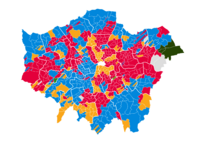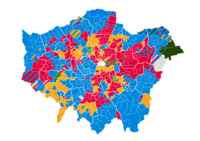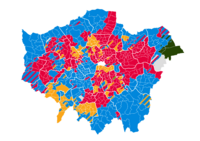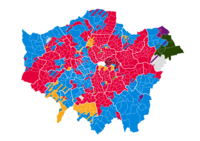London boroughs facts for kids
Quick facts for kids London borough |
|
|---|---|
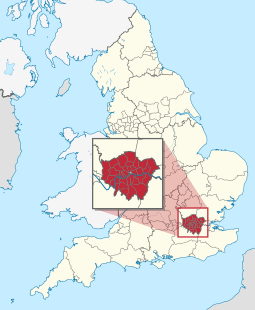 The thirty-two London boroughs in England |
|
| Category | Local authority districts |
| Location | Greater London |
| Created by | London Government Act 1963 |
| Created | 1 April 1965 |
| Number | 32 |
| Possible types | Inner London (12) Outer London (20) |
| Possible status | City (1) Royal borough (3) |
| Populations | 150,000–400,000 |
| Areas | 12–150 km2 |
| Government | London borough council |
The London boroughs are 32 special areas in Greater London, England. Each one has its own local government, called a London borough council. These councils help run things like schools, libraries, and waste collection for their local area. The boroughs were all created at the same time on April 1, 1965, by a law called the London Government Act 1963.
Twelve of these boroughs are in Inner London, which is the central part of the city. The other twenty are in Outer London, which is further out. The City of London, which is the very old heart of London, is a separate area and works differently from the boroughs. However, all these areas together make up Greater London. The whole of Greater London is also overseen by the Greater London Authority and the Mayor of London.
London boroughs usually have between 150,000 and 400,000 people living in them. Inner London boroughs are generally smaller in size and have more people living closer together than Outer London boroughs. The boroughs were formed by joining together older local government areas. Over time, there have been small changes to their borders.
Contents
How London Boroughs Work
London borough councils are in charge of most local services. This includes things like running schools, managing waste, providing social services, and looking after libraries. This is different from the Greater London Authority, which handles bigger, city-wide issues like major roads and overall planning.
Elections and Governance
The first councils for the boroughs were elected in 1964. They started their official work on April 1, 1965. Each borough is divided into smaller areas called electoral wards. People in these wards vote to choose their local councillors.
Council elections happen every four years. The most recent elections were in 2022, and the next ones will be in 2026. The main political parties in these councils are usually the Conservative, Labour, and Liberal Democrat parties.
Most councils (28 of them) use a "leader and cabinet" system. This means the council chooses a leader, and that leader picks a small group of councillors (the cabinet) to make important decisions. However, five boroughs have a directly elected mayor. This means people vote directly for a mayor who leads the council. These boroughs are Croydon, Hackney, Lewisham, Newham, and Tower Hamlets. The City of London is run by its own special group, the City of London Corporation.
List of London Boroughs
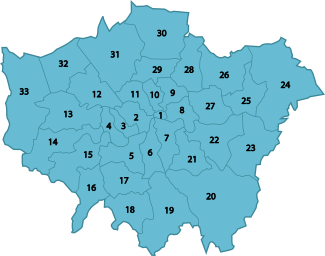 |
Four boroughs have slightly different official names. They don't include "London Borough" in their title. These are the City of Westminster, and the Royal Boroughs of Kingston upon Thames, Kensington and Chelsea, and Greenwich.
History of London Boroughs
How Boroughs Were Created
Before 1965, the Greater London area had many different types of local government. These included "county boroughs," "municipal boroughs," and "urban districts." Each had different powers and responsibilities. This made local government quite complicated.
To make things simpler, a special group called the Royal Commission on Local Government in Greater London was set up in 1957. They suggested creating 52 new "Greater London Boroughs." After some discussion, the government decided there would be 32 boroughs instead.
So, on April 1, 1965, the 32 London boroughs and Greater London were officially created by the London Government Act 1963. The 12 boroughs in the old County of London area became "Inner London" boroughs. The other 20 became "Outer London" boroughs. Outer London boroughs were responsible for education, but Inner London boroughs had a separate education authority for a while. The City of London continued to be run by its own special group, the City of London Corporation.
Elections for the new councils were held on May 7, 1964. The councils acted as "shadow authorities" for a year. This means they practiced their roles before officially taking over their powers in 1965.
Old Local Authorities
The new boroughs were formed by combining many older local areas. Since 1965, there have been only small changes to the borough borders, and two boroughs have changed their names.
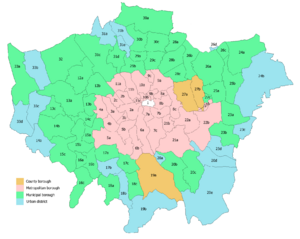
| London borough | Designation | Former areas | ||||
|---|---|---|---|---|---|---|
| Camden | Inner | Hampstead (11a) | St Pancras (11b) | Holborn (11c) | ||
| Greenwich | Inner | Greenwich (22a) | Woolwich (part) (22b) | |||
| Hackney | Inner | Hackney (9a) | Shoreditch (9b) | Stoke Newington (9c) | ||
| Hammersmith | Inner | Hammersmith (4a) | Fulham (4b) | |||
| Islington | Inner | Islington (10a) | Finsbury (10b) | |||
| Kensington and Chelsea | Inner | Kensington (3a) | Chelsea (3b) | |||
| Lambeth | Inner | Lambeth (6a) | Wandsworth (part) (6b) | |||
| Lewisham | Inner | Lewisham (21a) | Deptford (21b) | |||
| Southwark | Inner | Bermondsey (7b) | Camberwell (7c) | Southwark (7a) | ||
| Tower Hamlets | Inner | Bethnal Green (8a) | Poplar (8c) | Stepney (8b) | ||
| Wandsworth | Inner | Battersea (5b) | Wandsworth (part) (5a) | |||
| Westminster | Inner | Paddington (2c) | St Marylebone (2b) | Westminster (2a) | ||
| Barking | Outer | Barking (part) (25a) | Dagenham (part) (25b) | |||
| Barnet | Outer | Barnet (31a) | East Barnet (31b) | Finchley (31d) | Hendon (31c) | Friern Barnet (31e) |
| Bexley | Outer | Bexley (23b) | Erith (23a) | Crayford (23c) | Chislehurst and Sidcup (part) (23d) | |
| Brent | Outer | Wembley (12a) | Willesden (12b) | |||
| Bromley | Outer | Bromley (20c) | Beckenham (20b) | Orpington (20e) | Penge (20a) | Chislehurst and Sidcup (part) (20d) |
| Croydon | Outer | Croydon (19a) | Coulsdon and Purley (19b) | |||
| Ealing | Outer | Acton (13b) | Ealing (13a) | Southall (13c) | ||
| Enfield | Outer | Edmonton (30c) | Enfield (30a) | Southgate (30b) | ||
| Haringey | Outer | Hornsey (29b) | Tottenham (29c) | Wood Green (29a) | ||
| Harrow | Outer | Harrow (32) | ||||
| Havering | Outer | Romford (24a) | Hornchurch (24b) | |||
| Hillingdon | Outer | Hayes and Harlington (33c) | Ruislip Northwood (33b) | Uxbridge (33a) | Yiewsley and West Drayton (33d) | |
| Hounslow | Outer | Brentford and Chiswick (14c) | Feltham (14a) | Heston and Isleworth (14b) | ||
| Kingston upon Thames | Outer | Kingston upon Thames (16a) | Malden and Coombe (16b) | Surbiton (16c) | ||
| Merton | Outer | Mitcham (17c) | Merton and Morden (17b) | Wimbledon (17a) | ||
| Newham | Outer | West Ham (27a) | East Ham (27b) | Barking (part) (27c) | Woolwich (part) (27d) | |
| Redbridge | Outer | Ilford (26a) | Wanstead and Woodford (26b) | Dagenham (part) (26c) | Chigwell (part) (26d) | |
| Richmond upon Thames | Outer | Barnes (15a) | Richmond (15b) | Twickenham (15c) | ||
| Sutton | Outer | Beddington (18c) | Carshalton (18b) | Sutton and Cheam (18a) | ||
| Waltham Forest | Outer | Chingford (28a) | Leyton (28c) | Walthamstow (28b) | ||
Changes Over Time
Between 1965 and 1986, the London boroughs shared power with a larger body called the Greater London Council (GLC). The GLC handled big services like fire and ambulance. The borough councils handled local services like social care and libraries.
The GLC was closed down on April 1, 1986. After that, the borough councils took over some of the services the GLC used to provide, such as waste disposal. The Inner London boroughs also became responsible for education in their areas in 1990.
Some boroughs have changed their names. For example, the London Borough of Hammersmith became Hammersmith and Fulham in 1979. The London Borough of Barking became Barking and Dagenham in 1980.
Small changes have also been made to borough boundaries over the years. This was to make sure that communities were not split between different boroughs. For example, parts of Bromley and Croydon were moved to neighbouring counties in 1969.
In 2000, the Greater London Authority was created. This new authority includes the Mayor of London and the London Assembly. It took over some city-wide powers, like major highways and planning strategy, from the borough councils.
London Borough Councils
London borough councils are the main local authorities in London. They are elected every four years. They are responsible for running most local services. This includes schools, social services, waste collection, and local roads.
Some services that cover all of London are run by the Greater London Authority. Also, some councils work together to provide services. For example, some boroughs group together for waste collection and disposal. Each borough council is also a local education authority, meaning they are in charge of education in their area.
| Service | Greater London Authority | London borough councils |
|---|---|---|
| Education | ||
| Housing | ||
| Planning applications | ||
| Strategic planning | ||
| Transport planning | ||
| Passenger transport | ||
| Highways | ||
| Fire | ||
| Social services | ||
| Libraries | ||
| Leisure and recreation | ||
| Waste collection | ||
| Waste disposal | ||
| Environmental health | ||
| Revenue collection |
Councils Working Together
Sometimes, borough councils share services to save money. This means two or more boroughs might combine their efforts for certain services. For example, Westminster, Hammersmith & Fulham, and Kensington & Chelsea announced plans to combine many of their services. They would still keep their own political leaders and councillors, but staff and budgets would be shared. This helps them save money by working together.
Gallery of London-wide Election Results
- Results across Greater London Boroughs at ward level.
See also
 In Spanish: Municipio de Londres para niños
In Spanish: Municipio de Londres para niños


